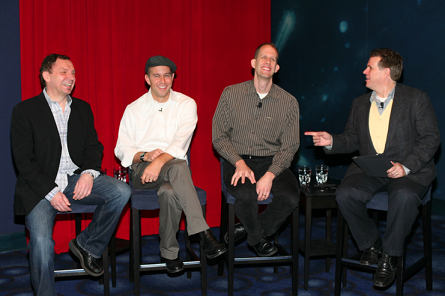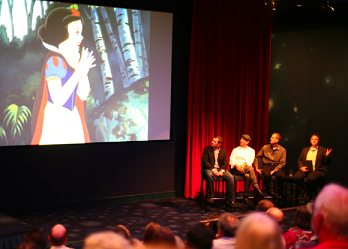 Can a man who was born more than a century ago still influence the best and brightest of his craft’s latest generation? He sure can…especially if he’s Walt Disney.
Can a man who was born more than a century ago still influence the best and brightest of his craft’s latest generation? He sure can…especially if he’s Walt Disney.
When Pixar Animation Studios was making Finding Nemo, for instance, a print of Bambi was brought in to inspire its creative team with the classic film's tone and feeling. The“computer people” wondered how the Disney animators—who drew their characters by hand—brought such richness to their work, according to Jonas Rivera, who has held a variety of positions at Pixar over more than 15 years, including producing the Oscar®-winning animated feature Up.
Academy Award®-winning Pixar director Pete Docter cites Dumbo as his biggest Disney influence. He called the 1941 feature “wonderfully simple,” and credited Disney animators for their ability to show emotional depth.
“We try to find the same emotional connection,” Docter said.
On Saturday, December 10 at The Walt Disney Family Museum, Rivera and Docter joined Walt Disney Animation Studios animator Andreas Deja on a panel to discuss Walt Disney’s creative identity and legacy.
Deja chose The Jungle Book as the Disney movie that had the greatest influence on him.
“Probably because it was the first one (he saw),” said Mr. Deja, who grew up in Germany. “But it’s still my favorite. It's a simple story with a lot of opportunity for the characters to have so much room. Things just happen.”
Disney historian and frequent Museum guest Jeff Kurtti moderated the event, called Walt Disney: An Entertainment Icon and Visionary. Kurtti sprinkled film clips of Walt and his films into the discussion, which was held in the Museum’s theater.
Kurtti showed a still from a 1937 Silly Symphony called The Old Mill, which, he said, Walt's team used to “test drive” a new piece of filmmaking technology—the Multiplane Camera. Walt Disney Studios wanted to find out what the new camera could really do before turning it loose on the big prize—Snow White and the Seven Dwarfs.
 More than 50 years later, Pixar Animation Studios took a page out of Walt’s book when it used Geri’s Game, a short about an old man who plays a game of chess (against himself), to improve its ability to make humans appear more…well…human.
More than 50 years later, Pixar Animation Studios took a page out of Walt’s book when it used Geri’s Game, a short about an old man who plays a game of chess (against himself), to improve its ability to make humans appear more…well…human.
“Humans were really hard for us,” Docter explained.
Geri’s Game, which was completed after Toy Story, also helped Pixar perfect animating “wavy cloth.” That technique came in handy forMonsters, Inc. and The Incredibles, Docter said.
Another Pixar short, For the Birds, was made to practice the “feather simulation” necessary to animate the “fur” for Sulley and similarly hairy creatures in Monsters, Inc.
Even the panel members were included in this unique walk down Disney memory lane. The presentation included shots of Docter and Rivera during childhood trips to Disneyland. (A 4-year-old Jonas was shown outside the old ticket booth, while Pete was shown with his siblings outside Sleeping Beauty Castle.)
“You knew in one sense that you were in the middle of an orange grove next to a freeway, but you could still believe you were on the Spanish Main, or in a rocket ship,” Docter said.
-- Sandy Hock, Volunteer at The Walt Disney Family Museum
Images above: 1) (L to R): Andreas Deja, Jonas Rivera, Pete Docter and Jeff Kurtti. Photo by Mark Gibson, courtesy The Walt Disney Family Museum. 2) Photo by Mark Gibson, courtesy The Walt Disney Family Museum.
